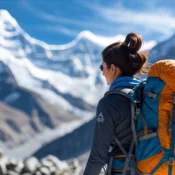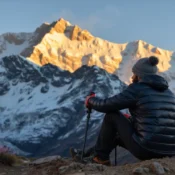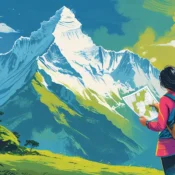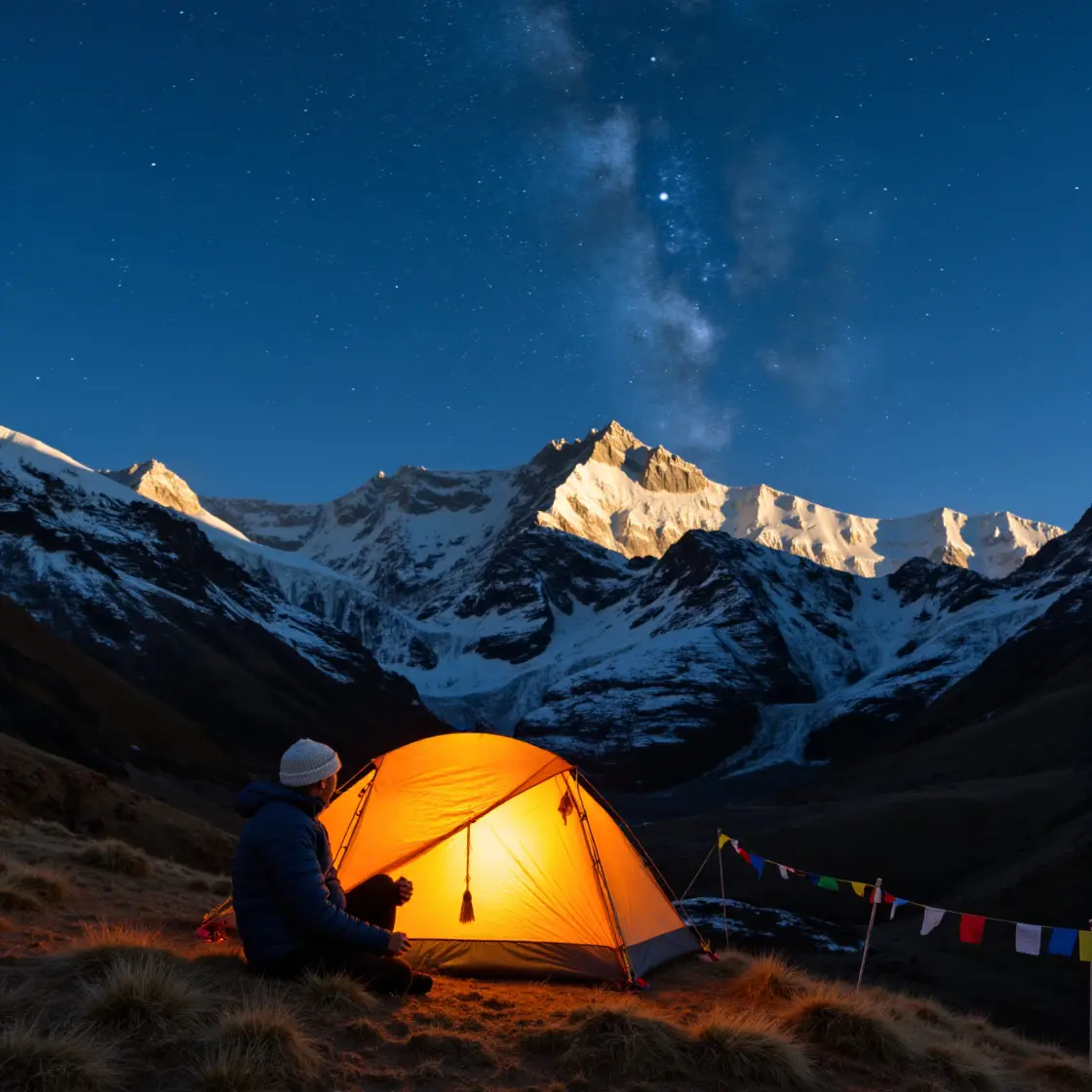Himalayan Trek Packing Guide: What to Carry?
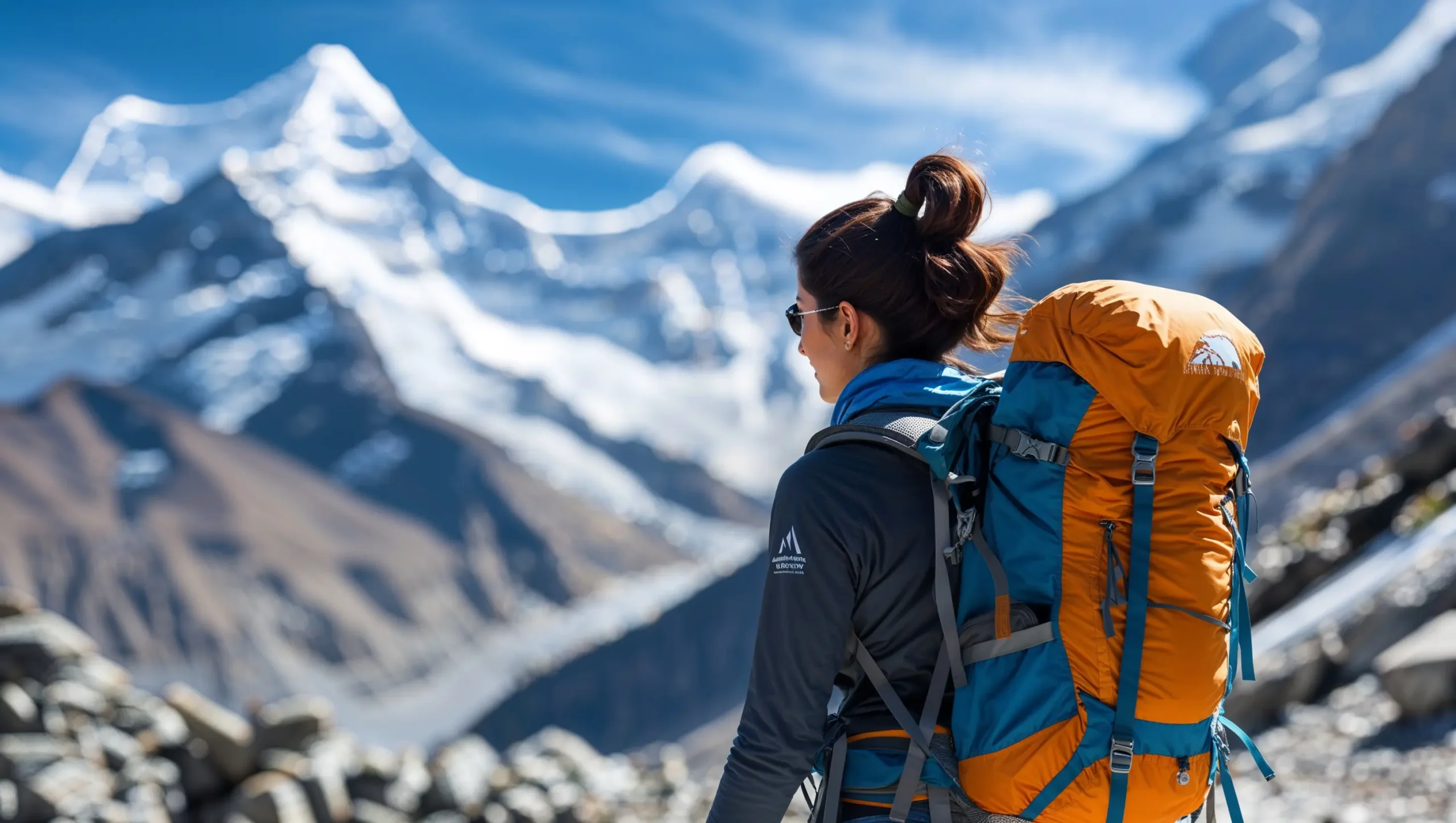
Himalayan Trek Packing Guide: What to Carry?
Think Before You Pack – The Himalayan Trekking Philosophy
Before you even unzip your duffel bag or browse for gear, take a moment to pause. The Himalayas are not an ordinary destination. They test your stamina, resilience, and judgment. And the very first test? What you pack.
A well-packed bag is more than convenience. It is your mobile survival kit. From freezing passes in Sikkim to unpredictable showers in Nepal, gear that works with the environment rather than against it can mean the difference between comfort and calamity.
This section lays down the core principles every trekker must internalize before assembling their kit.
1. The Rule of Three Layers: Base, Mid, and Shell
The golden rule for dressing in the Himalayas is layering. You do not need thick jackets or bulky sweaters. You need a smart, adjustable system that regulates body temperature as conditions change.
- Base Layer: This is your second skin. It should wick sweat away and dry fast. Merino wool or technical synthetics (like polyester blends) work best. Avoid cotton at all costs.
- Mid Layer: This insulates you. Use a fleece for active trekking or a lightweight down or synthetic jacket for rest breaks and evenings.
- Shell Layer: Your outer armor against wind, rain, and snow. A breathable waterproof jacket (Gore-Tex or equivalent) ensures your insulation layers stay dry and functional.
Pro tip: Carry a lightweight rain jacket even in clear weather. Mountain climates shift fast.
2. Ditch the Cotton: Use Technical Fabrics Only
Cotton may be comfortable at sea level, but it is a dangerous liability in the mountains. It soaks up sweat and rain, dries slowly, and loses all insulation value when wet. This can lead to hypothermia even in mild temperatures.
Instead, build your clothing system with:
- Merino wool (natural, odor-resistant, regulates temperature)
- Synthetic fabrics (fast-drying, durable, affordable)
Everything from your underwear to your t-shirts should be quick-dry. This is not about fashion. It is about function and survival.
3. Pack Light, Trek Far: Mastering Minimalism
The biggest rookie mistake? Overpacking.
“What if I need this?” is how trekkers end up with a 20 kg backpack and sore knees by Day 2.
Here’s how to avoid that:
- Only pack items with real, probable use
- Rent bulky items like sleeping bags or down jackets in hubs like Kathmandu or Gangtok
- Use gear that serves multiple functions (e.g., a buff as a hat, mask, or towel)
The lighter your pack, the more energy you preserve for the trail.
4. Waterproof Everything: Two-Level Defense
Rain, snow, river crossings—your gear is always at risk. A soaked sleeping bag or a wet thermal can ruin your trek or end it altogether.
Use a redundant waterproofing system:
- Outer defense: Rain cover for your backpack
- Inner defense: Dry bags or heavy-duty ziplocks for clothes, electronics, and sleeping gear
This double protection ensures that even if your outer layer fails, your critical gear stays dry.
Gear Checklist – Essentials You Cannot Skip
This section outlines the core equipment every Himalayan trekker needs. Whether you are navigating high passes in Nepal or remote valleys in Sikkim, these essentials remain the same. Each item here is selected for performance, not trend.
1. Clothing System: Build Your Protection Layer by Layer
Every clothing item should serve a specific function—managing moisture, trapping warmth, or shielding against the elements.
Base Layers
Pack two to three lightweight, quick-drying t-shirts. A mix of short and long sleeves offers flexibility in changing temperatures. Add one full set of thermal underwear made from synthetic fabric or merino wool, crucial for sleeping and high-altitude camps.
Mid Layers
Bring one breathable fleece for active warmth and one insulated jacket for static use. A down jacket is ideal for cold, dry climates, while synthetic insulation performs better in damp conditions.
Outer Shell
Carry a waterproof and windproof jacket with a breathable membrane. Pit zips or ventilation panels help release excess heat. A matching pair of shell pants is also necessary, especially if trekking during monsoon or snow seasons.
Trekking Pants and Shorts
Two pairs of stretchable, quick-dry trekking pants are sufficient. Convertible pants with zip-off legs are useful for variable conditions at different altitudes.
2. Footwear and Socks: Your Most Critical Gear
Good footwear supports your entire journey. Do not underestimate its impact.
Trekking Boots
Choose a high-ankle waterproof boot with a firm grip sole. Break them in well before the trek to avoid blisters or injuries. New boots on a Himalayan trail are a common cause of early exits.
Camp Shoes or Sandals
Lightweight sandals or slip-ons allow your feet to breathe after trekking. They also help prevent infections in shared bathrooms or campsites.
Socks
Carry three to four pairs of moisture-wicking hiking socks made of wool or synthetic blends. Add one or two warmer woollen pairs for nighttime use. Avoid cotton completely, as it retains moisture and leads to blisters.
3. The Big Three: Pack, Sleep, and Support Systems
These three items form the structural backbone of your trek.
Backpack and Daypack
Use a 40 to 60 liter backpack with an internal frame and padded hip belt. Add a rain cover for weather protection. If hiring a porter, pack your main gear in a duffel and use a 20 to 30 liter daypack for essentials like water, camera, and snacks.
Sleeping System
Even in teahouse treks, bring a personal sleeping bag rated to at least minus 10 degrees Celsius. For winter treks, choose a bag rated to minus 20 degrees or below. Add a sleeping bag liner for extra warmth and hygiene. For camping treks, a quality foam or inflatable sleeping mat is necessary for insulation.
Trekking Poles
Poles reduce knee strain and improve balance, especially on steep or rocky sections. Choose adjustable, collapsible models that fit easily into luggage.
4. Head and Hand Protection: Guard Your Extremities
The head, neck, and hands are most vulnerable to sunburn and cold exposure. A few small items make a big difference.
Headwear
Pack a wide-brimmed hat or sun cap for daytime. A wool or fleece beanie is essential for evenings and early mornings. A buff or neck gaiter provides flexible coverage for the face and neck in both sun and wind.
Gloves
Use a two-part glove system: thin liner gloves for mild conditions and waterproof insulated gloves or mittens for cold weather and snow exposure.
5. Essential Accessories and Electronics
These support systems cover hydration, lighting, navigation, and power—all critical in remote terrain.
Lighting
A reliable headlamp is mandatory. It keeps your hands free and is useful for early starts, camp chores, and emergencies. Carry spare batteries or a USB power bank with a built-in light as backup.
Hydration
Carry at least two liters of water using bottles or a hydration bladder. Add a steel flask or insulated thermos for hot drinks on cold days. Always include a water purification system—such as tablets, UV sterilizers, or a portable filter—since mountain water sources are not safe to drink untreated.
Sunglasses
Choose high-quality sunglasses with 100 percent UV protection. A wraparound design helps shield from peripheral glare, especially on snow-covered trails.
Documents and Power
Keep your passport, permits, travel insurance, and emergency contacts in a waterproof ziplock or dry pouch. A power bank of at least 10,000 mAh is strongly recommended for charging phones or headlamps.
Customize Your Pack – Seasons, Regions and Trekking Styles
No two Himalayan treks are the same. A packing list for a spring teahouse trek in Nepal is vastly different from what you need for a winter camping expedition in Sikkim. This section helps you adapt your core gear list based on three key variables:
- The season you are trekking in
- The region and altitude profile
- The style of the trek (teahouse vs. camping)
A. Packing by Season: How Weather Changes Your Gear Strategy
The Himalayas go through extreme seasonal shifts—from freezing winters to soaking monsoons. Each requires targeted adjustments to your gear.
Winter (December to February)
- Add insulated, fleece-lined trekking pants
- Use a sleeping bag rated to minus 20 degrees Celsius or lower
- Pack thermal flask for hot drinks
- Carry traction gear like microspikes or crampons
- Gaiters protect your lower legs from snow and slush
- Use layered gloves and a full balaclava for cold nights
Monsoon (June to August)
- Prioritize full rain protection (poncho or waterproof jacket that also covers your pack)
- Carry leech socks and strong insect repellent
- Add extra quick-dry t-shirts and socks
- Use dry bags for internal packing; avoid cotton completely
- Pack antifungal powder and keep spare socks accessible
Spring (March to May) and Autumn (September to November)
- These are the most stable seasons for trekking
- The standard three-layer system is usually sufficient
- Morning and night temperatures may still drop at high altitude
- Carry a fleece hat, buff, and a sleeping bag rated to minus 10 degrees Celsius
Quick Gear Reference by Season:
| Gear Item | Spring/Autumn | Monsoon | Winter |
|---|---|---|---|
| Sleeping Bag Rating | Minus 10°C | Plus 5°C | Minus 20°C or lower |
| Outer Jacket | Waterproof Shell | Poncho + Rain Shell | Heavy Down Jacket |
| Bottom Layers | Trekking Pants | Waterproof Shell Pants | Fleece-lined + Shell |
| Footwear Grip | Moderate Grip | Strong Grip | Microspikes Essential |
| Key Add-ons | Buff, Sunglasses | Leech Socks, Repellent | Balaclava, Thermos, Gaiters |
B. Packing by Region and Trek Style
Your destination also dictates what you can leave behind or must carry. Trekking in Nepal often means lighter loads. Indian Himalayan treks typically involve camping, which shifts logistics.
Nepal (Everest, Annapurna, Langtang)
- These routes are supported by teahouses offering meals and accommodation
- No need to carry tents, mats, or cooking gear
- Sleeping bag is optional, but highly recommended for warmth and hygiene
- Electricity is often available at a cost, but unreliable—carry a power bank
- Pack for ease and speed—mobility is more important than carrying everything
Sikkim and Indian Himalayas (Goechala, Green Lake, Pin Bhaba)
- These treks are camping-based, with porters or pack animals carrying gear
- Your gear will go into a large duffel bag, provided by most local agencies
- Personal load in your daypack should not exceed 5 to 6 kilograms
- Weight limit for duffel is typically 10 to 15 kilograms
- Expect zero charging facilities—carry extra batteries and power backups
- Sleeping mat, sleeping bag, and adequate cold-weather clothing are essential
C. Rent or Buy in Nepal: Smarter Trekker Decisions
If you are starting your trek from Kathmandu or Pokhara, you have the advantage of access to budget-friendly rental shops. But not everything is worth renting.
What You Should Always Buy
- Trekking boots (must be broken in)
- Base layers and socks (for hygiene)
- Sunglasses and water filters
- Power banks and headlamps
What You Can Safely Rent
- Down jackets
- Sleeping bags (check temperature rating and cleanliness)
- Trekking poles
- Duffel bags for porter use
What to Watch Out For
- Many shops rent counterfeit gear with weak stitching, poor insulation, or broken zippers
- Always inspect gear carefully—zippers, seams, and insulation thickness
- Prices are negotiable in local shops, but not in branded outlets
D. Responsible Trekking: Sustainability Practices That Matter
The Himalayas are beautiful, fragile ecosystems. How you pack affects not just your trek, but the environment you walk through.
Sustainable Gear Choices
- Choose clothing made from recycled or biodegradable materials
- Support brands with fair trade or eco-conscious certifications
- Invest in durable items that last multiple treks
On-Trail Practices
- Avoid single-use plastics—carry purification tools instead of buying bottled water
- Pack out all trash, including toilet paper and hygiene products
- Use biodegradable soap for washing and showering
- Carry reusable bags for snacks, waste, and sorting laundry
Gear Longevity Tips
- Dry sleeping bags and jackets properly after each trek
- Clean gear with non-toxic detergents
- Reapply waterproofing sprays or patches to extend gear lifespan
4: Hygiene and Health Essentials
In the Himalayas, hygiene and health are more than comfort—they are critical to survival and well-being. Whether you are on a camping expedition in Sikkim or a teahouse trail in Nepal, minor issues like poor sanitation, dehydration, or an untreated blister can escalate into serious problems.
This section outlines how to maintain personal hygiene, manage altitude-related risks, and pack smart for both men and women.
1. Minimalist Toiletry Kit: Just the Essentials
You do not need a full bathroom cabinet. Everything should be lightweight, compact, and biodegradable.
Must-Have Items
- Travel-sized toothbrush and toothpaste
- Biodegradable soap or all-in-one body wash
- Microfiber quick-dry towel (compact and fast-drying)
- Sunscreen (SPF 30 or higher, broad spectrum)
- Lip balm with SPF
- Unscented wet wipes (for sponge baths on no-shower days)
- Nail clippers and tweezers (shared use, if needed)
- Hand sanitizer (small bottle with clip-on cap)
Smart Tips
- Use a hanging toiletry bag to keep items dry and organized
- Always pack out used wipes in a ziplock bag
- Never dispose of sanitary or plastic items on the trail
2. Trekker’s First-Aid Kit: Built for the Mountains
A standard travel first-aid kit is not enough. Himalayan treks demand altitude-specific and remote-ready medical supplies. Build your kit in three layers: wound care, medication, and general health.
Wound Care
- Antiseptic wipes
- Adhesive bandages in multiple sizes
- Blister plasters or Compeed
- Gauze pads and medical tape
- Moleskin or duct tape (for “hot spots”)
- Tweezers and small scissors
Medications
Always consult a doctor before your trek.
- Ibuprofen or paracetamol (pain and fever relief)
- Antihistamines (for allergies or insect bites)
- Anti-diarrheal tablets (e.g. Loperamide)
- Oral rehydration salts (ORS)
- Broad-spectrum antibiotic (e.g. Ciprofloxacin or Azithromycin)
- Acetazolamide (Diamox) for preventing altitude sickness
- Dexamethasone (emergency use for cerebral edema)
- Nifedipine (emergency use for pulmonary edema)
General Supplies
- Personal prescription medication (with backup doses)
- Throat lozenges (for dry air and cough)
- Thermometer strips or digital thermometer
- Small ziplocks for pill organization
- Lightweight emergency whistle
Important Note:
Altitude medications like Diamox, Dexamethasone, and Nifedipine must be taken only under proper medical advice. Always inform your guide if carrying them.
3. Women-Specific Hygiene and Packing Tips
Trekking while menstruating is absolutely manageable with the right preparation. However, disposal facilities are almost nonexistent at higher altitudes, so everything must be packed out responsibly.
Clothing and Comfort
- Two to three quick-dry, moisture-wicking sports bras
- Multiple pairs of merino or synthetic underwear
- Avoid cotton undergarments to reduce chafing and infection risk
Menstrual Hygiene
- Carry your preferred products (pads, tampons, menstrual cups)
- Use opaque, sealable ziplock bags to pack out used products
- Bring extra wet wipes and hand sanitizer
- Consider pain relief tablets for cramps
- Track your cycle in advance and prepare for delays due to altitude changes
Optional Convenience Items
- Female urination device (FUD) for use in cold or exposed areas
- Small privacy poncho or cloth for field use
- Lightweight pee funnel bottle for nighttime use inside a tent
Quick Tips for Trek Health & Hygiene
- Never drink untreated water—use a purifier or tablets
- Wash hands before every meal and after toilet use
- Air out feet and change into dry socks after each day’s trek
- Keep fingernails trimmed and clean
- Store all medicines in waterproof pouches
A hygienic trek is a healthy trek. You cannot always control the environment, but you can control how prepared you are. Carry only what you need, keep it clean, and treat minor issues before they become major.
5: What NOT to Pack – Common Mistakes That Add Weight and Regret
Many trekkers pack with the mindset of “just in case.” The result? Heavy, bloated backpacks filled with items that never see the light of day.
Overpacking is not just inconvenient—it can slow you down, strain your joints, and impact your trek’s success. The best trekkers carry only what they need. Here is a list of items to leave behind, no matter how tempting they seem.
1. Cotton Clothing and Denim
Cotton absorbs moisture and dries slowly, which is dangerous in high-altitude climates. Wet cotton chills the body and offers no insulation.
Avoid:
- Cotton t-shirts
- Jeans
- Sweatshirts
- Cotton underwear and socks
2. Fashion Jackets and Accessories
Mountain trails are not fashion runways. Heavy leather jackets, decorative scarves, or lifestyle winter coats lack the technical features needed for protection and performance.
Avoid:
- Woolen trench coats
- Leather jackets
- Decorative scarves or shawls
- Bulky, non-insulated parkas
3. Excess Footwear
You only need two pairs: your main trekking boots and a lightweight camp shoe. Carrying sneakers, extra sandals, or slippers just adds bulk.
Avoid:
- Spare sports shoes
- Multiple sandals
- Flip-flops without purpose
4. Full-Size Toiletries
Large bottles of shampoo, lotion, or body wash take up unnecessary space and weight. They also increase the risk of spills.
Avoid:
- Full-size shampoo or conditioner
- Large toothpaste tubes
- Bulk lotion or sunscreen containers
Use small travel-sized containers or solid alternatives instead.
5. Too Many Snacks
Carrying some trail mix or energy bars is smart. Bringing a week’s supply of chocolates, dry fruits, and packaged food is not.
Avoid:
- Packets of chips, biscuits, or sweets
- Glass jars or tins
- Heavy snack bundles from home
Shops along common routes (like Everest Base Camp or Annapurna Circuit) often sell basic snacks. Carry only a small supply of personal favorites.
6. Unnecessary Electronics
The Himalayas are not the place for digital overload. Electricity is limited and often unreliable. Stick to what you truly need.
Avoid:
- Laptops and tablets
- Bluetooth speakers
- Multiple cameras and lenses
- Extension cords or large power banks (more than 20,000 mAh is overkill for most)
Stick to one multipurpose device—your phone is often enough for photos, notes, and communication.
7. Physical Books and Heavy Reading Material
Books are comforting on rest days, but even one paperback can weigh more than a fleece. If reading is essential, opt for an e-reader or offline app.
Avoid:
- Novels and hardcovers
- Guidebooks with repetitive information (download offline versions)
8. Camping Gear You Do Not Need
If you are on a teahouse trek, there is no need to carry tents, cooking utensils, or sleeping mats. These only apply to self-supported or camping expeditions.
Avoid:
- Tents
- Cookware or portable stoves
- Sleeping mats (if agency provides one)
Final Pre-Trek Downloadable Checklist :
Final Advice:
If you are unsure about an item, ask yourself:
- Will I use this daily?
- Is this essential for safety, hygiene, or survival?
- Can I rent or borrow this at the base town?
If the answer is no, it probably does not belong in your backpack.

